Advertisements
Advertisements
Question
Distinguish between:
Unitary elastic demand and Relatively elastic demand
Solution
| Unitary elastic demand | Relatively elastic demand |
| When a percentage change in price leads to a proportionate change in quantity demanded then demand is said to be unitary elastic. | In this case, the change in price leads to a proportionately large change in the quantity demanded. |
|
It represents a 'rectangular hyperbola' demand curve.
|
It represents a flatter demand curve.
 |
| Symbolically it is represented as Ed = 1 |
Symbolically it is represented as Ed > 1.
|
| For example, 50% fall in price of a commodity leads to 50% rise in quantity demanded. |
For example - a 50% fall in price leads to a 100% rise in quantity demanded.
|
APPEARS IN
RELATED QUESTIONS
Distinguish between Relatively elastic demand and relatively inelastic demand.
The demand curve is parallel to the X-axis in the case of ______.
When the percentage change in quantity demanded is more than the percentage change in price, the demand curve is ______.
Ed = 0 in case of ______.
Perfectly elastic demand : Ed = ∞ : : _______ : Ed = 0
Complete the correlation:
Rectangular hyperbola : ______ : Steeper demand curve : Relatively inelastic demand.
Assertion and Reasoning type of question:
- Assertion (A): The degree of price elasticity is less than one in case of relatively inelastic demand.
- Reasoning (R): The change in demand is less than the change in price.
In the following diagram, AE is the linear demand curve of a commodity. On the basis of the given diagram state whether the following statement is True or False. Give a reason for your answer.

Demand at point ‘C’ is relatively elastic demand.
In the following diagram, AE is the linear demand curve of a commodity. On the basis of the given diagram state whether the following statement is True or False. Give a reason for your answer.

Demand at point ‘B’ is unitary elastic demand.
In the following diagram, AE is the linear demand curve of a commodity. On the basis of the given diagram state whether the following statement is True or False. Give a reason for your answer.

Demand at point ‘D’ is perfectly inelastic demand.
In the following diagram, AE is the linear demand curve of a commodity. On the basis of the given diagram state whether the following statement is True or False. Give a reason for your answer.

Demand at point ‘A’ is perfectly elastic demand.
Identify and define the degrees of elasticity of demand from the following demand curve.

Identify and define the degrees of elasticity of demand from the following demand curve.
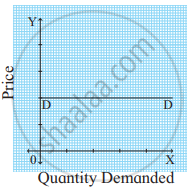
Identify and define the degree of elasticity of demand from the following demand curve.
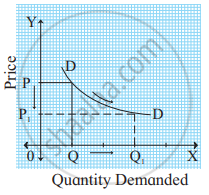
Statements that are incorrect in relation to perfectly inelastic demand:
- Percentage change in price has no effect on quantity demanded
- Co-efficient of elasticity is equal to 1 (ed=1).
- Demand curve is a horizontal line parallel to X axis.
- It is a type of price elasticity of demand.
Relatively elastic demand : Ed > 1 :: Relatively inelastic demand : ______.
Infinite change in the quantity demanded of a commodity taking place due to slight or zero change in the price −
Demand curve is parallel to 'Y' axis in case of ______.
Assertion (A): The slope of demand curve is a rectangular hyperbola in case of unitary elastic demand.
Reasoning (R): In unitary elastic demand, percentage change in price leads to more than proportionate change in quantity demanded.
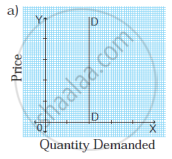 |
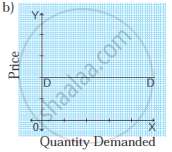 |
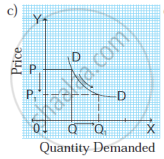 |
 |
Questions:
- Identify the types of price elasticity of demand from above diagram. (2m)
- Write slope of demand curve in above diagrams. (2m)
Explain the types of price elasticity of demand.
Complete the correlation.
Perfectly elastic demand : Ed = ∞ :: ______ : Ed = 1.
When the percentage change in quantity demanded is Less than the percentage change in price the demand curve is ______
Identify and explain the following concept.
Ramesh's demand for salt remained unchanged lnspite of a 10% rise in its price.
Study the following figure and answer the question given below it.
Identify the price elasticity of demand from the following diagram:
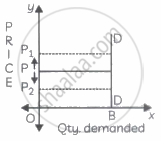
Study the following figure and answer the question given below it.
Identify the price elasticity of demand from the following diagram:
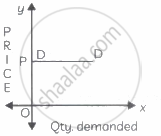
Study the following figure and answer the question given below it.
Identify the price elasticity of demand from the following diagram:

Study the following figure and answer the question given below it.
Identify the price elasticity of demand from the following diagram:
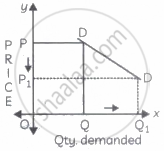
The price elasticity of demand on a linear demand curve at the Y-axis is equal to ______.
Identify and explain the concept from the given illustration:
A fall in the price of ice cream by 50% resulted in a 20% rise in its demand.
Study the following diagram and answer the questions:
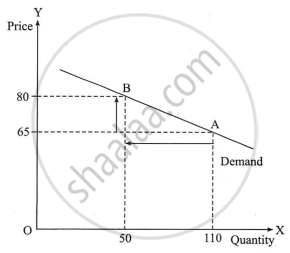
Questions:
- Calculate the price elasticity of demand using the ratio method.
- Find out the type of price elasticity of demand.
Complete the correlation:
Relatively inelastic demand : Perishable goods : : Relatively elastic demand : ______.
Identify and explain the concept from the given illustration:
A fall in the price of medicines by 30% resulted in no rise in demand for it.
Find the odd word out:
Types of price elasticity of demand:
Find the odd word out:
Products having relatively inelastic demand:
Distinguish between:
Relatively Elastic Demand and Perfectly Elastic Demand
Complete the correlation:
Perfumes : ______ : : Medicines : Relatively inelastic demand.
Identify and explain the concept from the given illustration:
Demand for perfumes increased by 10% when its price decreased by 30%.

